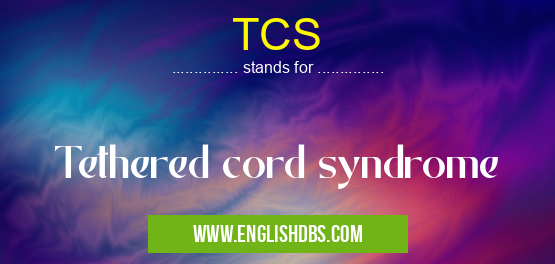What does TCS mean in HEALTHCARE
Tethered cord syndrome (TCS), also known as anchored spinal cord, is a medical condition that occurs when the spinal cord is abnormally attached to the surrounding tissues, usually near the end of the spinal cord. This attachment can restrict the normal movement of the spinal cord and lead to various neurological problems.

TCS meaning in Healthcare in Medical
TCS mostly used in an acronym Healthcare in Category Medical that means Tethered cord syndrome
Shorthand: TCS,
Full Form: Tethered cord syndrome
For more information of "Tethered cord syndrome", see the section below.
» Medical » Healthcare
Causes of TCS
- Congenital: Present at birth due to abnormal development in the womb.
- Acquired: Occurs after birth due to trauma, surgery, or infection.
Symptoms of TCS
Symptoms vary depending on the location and severity of the tethering:
- Back pain or discomfort
- Leg weakness or numbness
- Scoliosis or other spinal deformities
- Bowel or bladder incontinence
- Difficulty walking or running
- Foot deformities
Diagnosis of TCS
- Physical examination: Assess neurological function and spinal mobility.
- Magnetic resonance imaging (MRI): Provides detailed images of the spinal cord and surrounding structures.
- Electromyography (EMG) and nerve conduction studies: Evaluate nerve function.
Treatment for TCS
- Observation: Monitoring for symptoms and progression for mild cases.
- Surgery (untethering): Releasing the tethered cord to restore normal mobility.
- Physical therapy: Strengthening exercises and mobility training.
- Medication: Pain relievers or muscle relaxants to manage symptoms.
Essential Questions and Answers on Tethered cord syndrome in "MEDICAL»HEALTHCARE"
What is tethered cord syndrome (TCS)?
TCS is a condition that occurs when the spinal cord is abnormally attached to the bony structures of the spine. This can cause a variety of neurological problems, including weakness, numbness, and pain in the legs and feet.
What are the symptoms of TCS?
Symptoms of TCS can vary depending on the severity of the condition. Some common symptoms include:
- Weakness in the legs and feet
- Numbness or tingling in the legs and feet
- Pain in the legs and feet
- Difficulty walking
- Incontinence
- Sexual dysfunction
What causes TCS?
TCS is usually caused by a birth defect that occurs during pregnancy. In some cases, TCS can also be caused by a spinal cord injury.
How is TCS diagnosed?
TCS is diagnosed through a physical examination and a variety of tests, including:
- MRI scan
- CT scan
- Electromyography (EMG)
- Nerve conduction studies
How is TCS treated?
The treatment for TCS depends on the severity of the condition. Treatment options include:
- Surgery to release the tethered spinal cord
- Physical therapy
- Occupational therapy
- Medications
What is the prognosis for TCS?
The prognosis for TCS depends on the severity of the condition and the age at which it is diagnosed. Early diagnosis and treatment can improve the prognosis.
Final Words: Tethered cord syndrome is a complex condition that requires prompt diagnosis and treatment to prevent further neurological damage. By understanding the causes, symptoms, and treatment options, healthcare professionals and patients can work together to manage TCS effectively.
TCS also stands for: |
|
| All stands for TCS |
